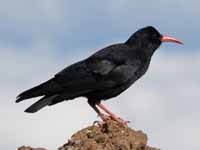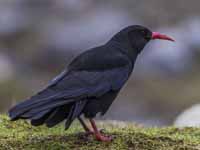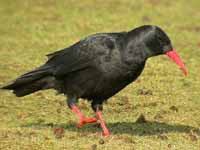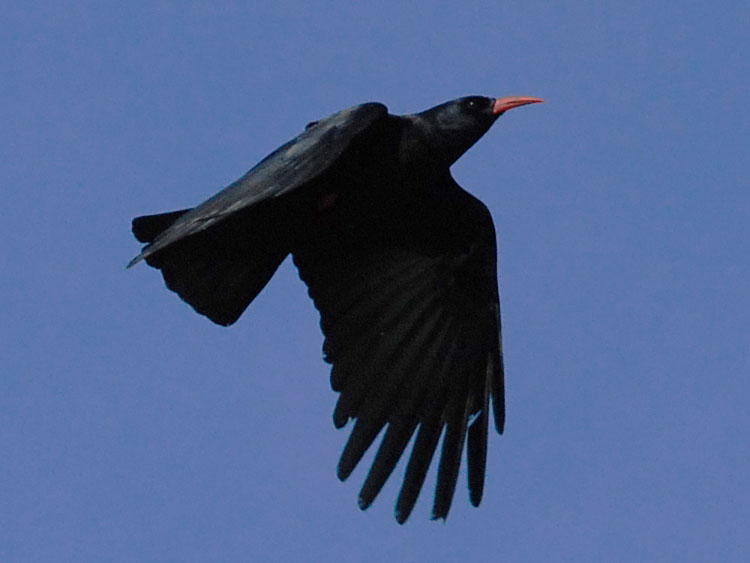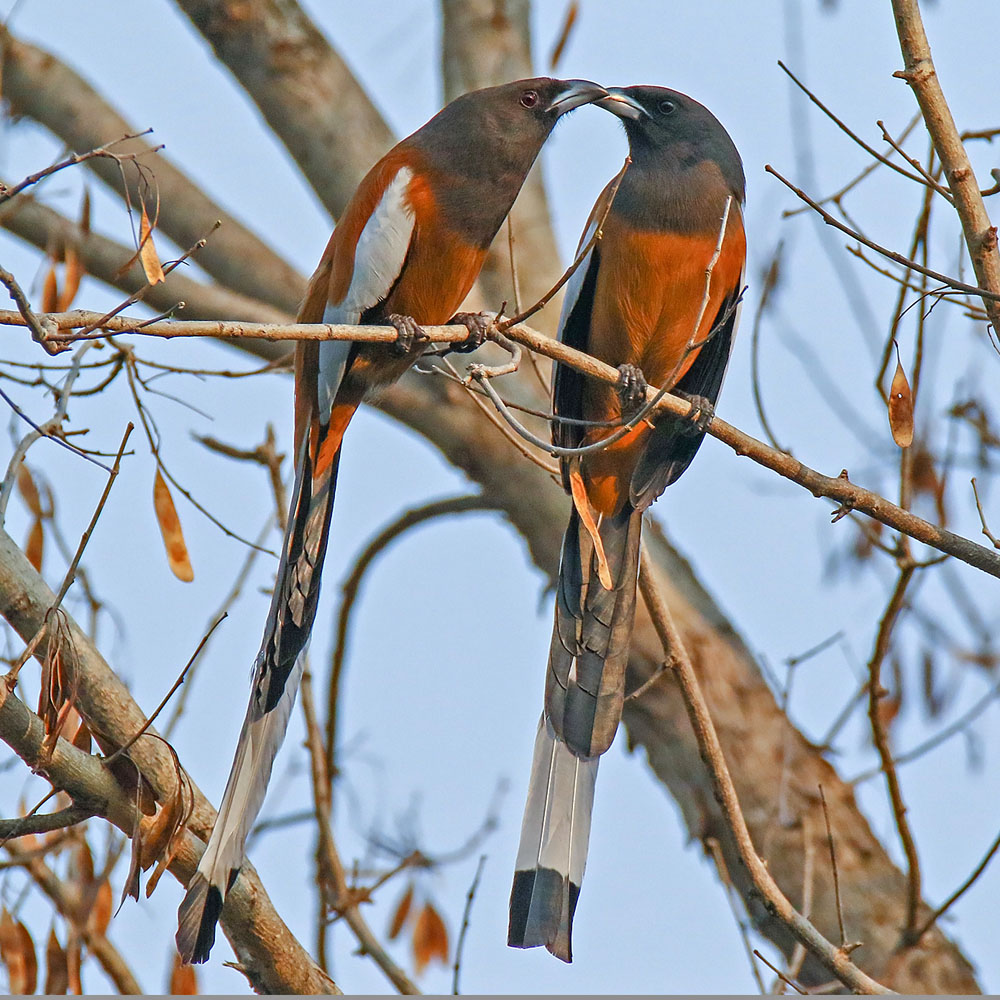THE WORLD BIRDS - An Online Bird Book
CORVIDAE
CORVIDAE
The Corvidae family contains the crows, ravens, rooks, jackdaws, jays, magpies, treepies, choughs and nutcrackers. These species are grouped into subfamilies that are outlined in the table that follows. Beware that names such as jays, magpies, or treepies are not always assigned in a consistant manner. For example, the black magpie (Platysmurus leucopterus) belongs to the treepie subfamily.
| SUBFAMILY | MEMBERS |
| Corvinae | True crows of genus Corvus includes the crows, ravens, rooks, jackdaws. |
| Corvinae (continued) | Jays of genus Garrulus, nutcrackers of Nucifraga, magpies of Pica, ground-jays of Jay Podoces, and the piapiac of Ptilostomus, and Stresemann's bush-crow of Zavattariornis. |
| Cissinae | Green-magpies of Cissa and the blue-magpies of Urocissa. |
| Cyanocoracinae | Most of the species that are named "jay". |
| Crypsirininae | Treepies |
| Perisoreinae | Three jay species of Perisoreus and Magpies of Cyanopica |
Corvids are medium to large in size, with strong feet and bills, and a single moult each year (most passerines moult twice). Most species have bristle-like feathers covering their nostrils. They are omnivores having a varied diet of animal and plant material. Makes average slightly heavier than females. Corvids are found worldwide except for the tip of South America and the polar ice caps.
Treepies are found in tropical forests of Southeast Asia. They are highly arboreal and rarely come to the ground to feed.They move through the trees with great agility using their long tales for balancing. Even when flying from tree to tree they tend to stay in the canopy which makes them difficult to study or photograph. Treepies are usually more easily heard than seen. They are a collection of loud species with an amazing variety of sounds: melodious, metallic, harsh, and sqawking. Being able to create such a repertoire of sounds, it is not surprising that they some have the ability to mimic other species.
They resemble many of the magpies, which also belong to the Corvidae family. In particular, the blue-magpies of genus Urocissa, also have long tails, a similar shaped compact body, and are found in Asia. The treepies range from 29 to 48 cm in length, this measurement including the long tail. Their weight varies from 80 to 180 grams. Most treepies are black, white, grey or brown. Their stout and down-curved bill has a curved culmen (the top surface of the upper-bill), and the cutting edges are also rounded.
Treepies are omnivores and content to eat what is available: invertebrates such as grasshoppers, caterpillars, beetles, and moths are at the top of their list. On the plant side of their diet, they will eat fruit, berries, and seeds. They are know to also eat small reptiles and small birds. Because of their varied diet, most of the treepies have a conservation status of Least Concern. However, because they are highly arboreal, they are susceptible to deforestation and as a result the hooded treepie is Near Threatened and the Andaman Treepie is Vulnerable.
Their cup-shaped nests are made out of twigs, which are often prickly, and lined with smaller twigs and soft plant material. The nests are placed in trees or tall shrubs, usually 3 to 6 meters off the ground. The treepies have an average of 3 to 4 eggs. Because their nests are usually hard to locate, little is known about their incubation period or how long it takes the chicks to fledge.
Genus Crypsirina
These two treepie species have long tails that widen substantially at the end.
Treepie,_Hooded Crypsirina cucullata
Description: The hooded treepie has mainly light grey plumage. It has a black head and long black tail which ends in a larger spoon-shape. The edges of the tail are grey, but that color is usually not visible at rest. It has a thick and down-curved black bill which is lighter at the edges. The legs are also black. It is 29 to 31 cm long and weighs 130 to 135 grams. The nest, which usually in a thicket or on a small tree, sits on a thorny base and is partially covered by a thony dome.
Range: Myanmar.
Habitat: Dry forests, bamboo thickets, dense thorn-scrub.
Diet: Insects. Feeds protected from view in a thicket.
Conservation status: The hooded treepie is listed as Near Threatened because of habitat loss.
Image by:
1) John Gould 2) Lonelyshrimp - MyanmarRange: Myanmar.
Habitat: Dry forests, bamboo thickets, dense thorn-scrub.
Diet: Insects. Feeds protected from view in a thicket.
Conservation status: The hooded treepie is listed as Near Threatened because of habitat loss.
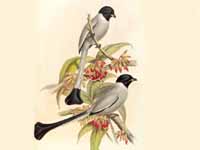

Treepie,_Racket-tailed Crypsirina temia
Description: The racket-tailed treepie has mainly green plumage which can look blackish in poor light. It has a black forehead which is comprised of thick feathers. The long green tail broadens at the end. The eyes are bluish and the thick and down-curved bill is grey as are the feet. It is 29 to 31 cm long and weighs 115 to 145 grams. The nest, which is created from twigs and plant material, is hidden in s thicket, or some bamboo.
Range: Southeastern Asia, Java, Bali.
Habitat: Primary and secondary forests, their edges and clearings.
Diet: Invertebrates such as beetles, fruits, berries.
Conservation status: Least Concern.
Range: Southeastern Asia, Java, Bali.
Habitat: Primary and secondary forests, their edges and clearings.
Diet: Invertebrates such as beetles, fruits, berries.
Conservation status: Least Concern.
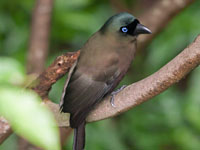
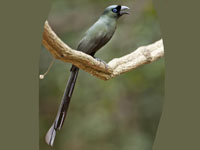
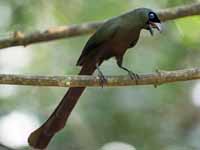
Genus Dendrocitta
This genus contains 7 of the 11 treepie species. These treepies are plumaged in black, grey and rufous. The have a long graduated tails. The legs are short and weak. Typically, the face and flight feathers are black, and the back is rufous. They are highly arboreal and rarely come to the ground to feed. Their nests are made out of twigs, which are often prickly, and lined with smaller twigs and soft plant material. The nests are placed in trees or tall shrubs, usually 3 to 6 meters off the ground. These treepies have an average of 3 to 4 eggs.
Treepie,_Andaman Dendrocitta bayleii
Description: The Andaman treepie has dark brown upperparts, and a bluish-grey head with the face almost black. It has a short and stout down-curved dark grey bill. The underparts as will as the rump are rufous. The upper-wings are black with a white patch. It has a long black tail. The Andaman treepie is 32 cm long and weighs 90 to 110 grams.
Range: Indian island of Andaman.
Habitat: Subtropical or tropical moist lowland forests. It prefers large trees.
Diet: Probably omnivorous.
Conservation status: The Andaman treepie is listed as Vulnerable because of its limited range and forest destruction.
Image by: 1) John Gerrard Keulemans Range: Indian island of Andaman.
Habitat: Subtropical or tropical moist lowland forests. It prefers large trees.
Diet: Probably omnivorous.
Conservation status: The Andaman treepie is listed as Vulnerable because of its limited range and forest destruction.
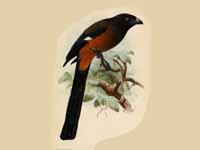
Treepie,_Bornean Dendrocitta cinerascens
Description: The Bornean treepie has a greyish back, pale silver crown, pinkish-brown head and underparts, a pale rump, and black wings with a white patch. It has a long and graduated grey tail with a black terminal band. It is 40 cm in length and weighs 125 grams. The nest is made of twigs and lined with softer plant material. It is placed in a small tree or tall shrub.
Range: Southeast Asian island of Borneo.
Habitat: Hilly forests; also bamboo groves.
Diet: Grasshoppers, beetles, moths, fruits, seeds, human leftovers.
Conservation status: Least Concern.
Image by: 1, 2) Kip Kee 3) ReubenSTRange: Southeast Asian island of Borneo.
Habitat: Hilly forests; also bamboo groves.
Diet: Grasshoppers, beetles, moths, fruits, seeds, human leftovers.
Conservation status: Least Concern.
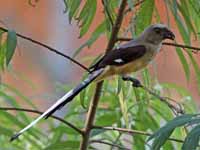
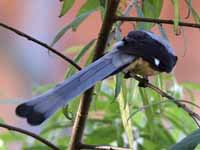
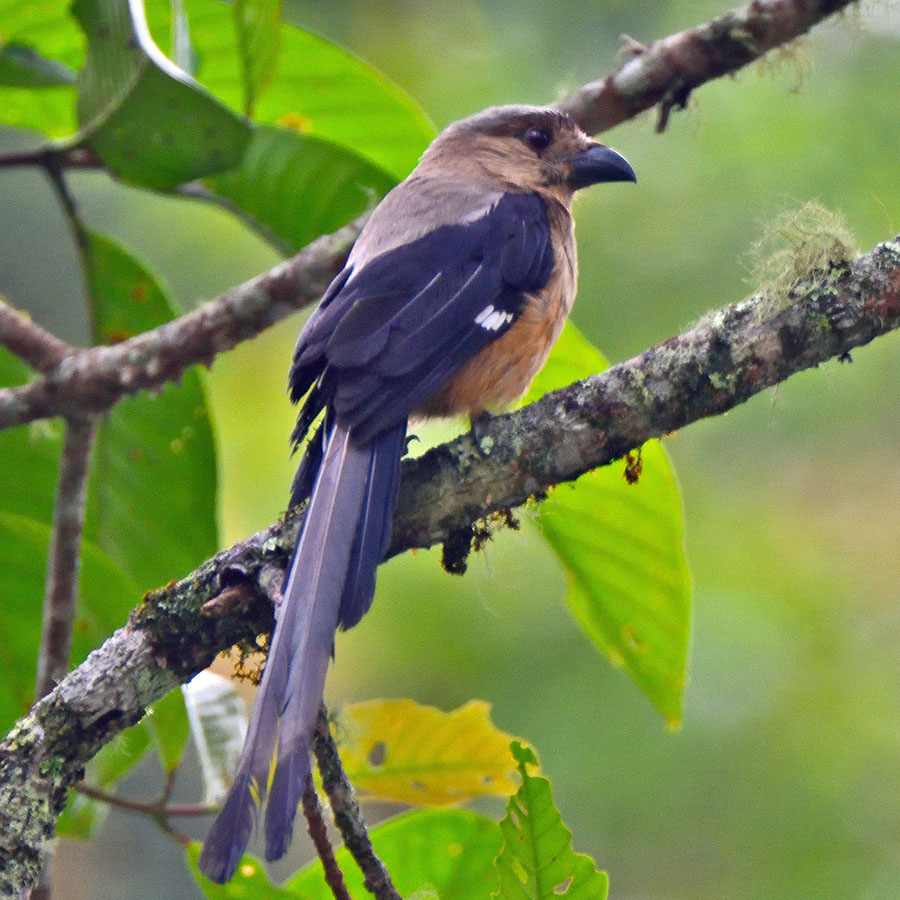
Treepie,_Collared Dendrocitta frontalis
Description: The collared treepie has a black forehead, face, bib, and tail. It has a light silvery breast, neck, and shoulders. It also has a chestnut brown back, rump, and belly. The wing coverts are white, primaries black, and the long tail is black. It is 38 cm long and weighs 100 grams. The nest is a small, neat structure often placed in bamboo clumps, small trees or bushes at the edge of a clearing. There are 3-5 eggs.
Range: Eastern Indian Himalayas, Bangladesh, Nepal, Myanmar.
Habitat: Bamboo, hill forests often at quite high elevations.
Diet: Invertebrates including winged termites in flight. Also fruits and berries.
Conservation status: Least Concern.
Image by: 1) Pkspks Range: Eastern Indian Himalayas, Bangladesh, Nepal, Myanmar.
Habitat: Bamboo, hill forests often at quite high elevations.
Diet: Invertebrates including winged termites in flight. Also fruits and berries.
Conservation status: Least Concern.
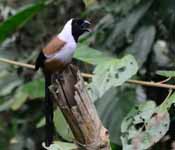
Treepie,_Grey Dendrocitta formosae
Description: The grey treepie has mainly grey plumage. The grey underparts becomes whiter towards the rump which is rufous. It has a brownish back and a black forehead. The black wings have a white patch. Western birds have a greyish rump and some grey in tail while the eastern forms have a white rump and a black tail. It is 36 to 40 cm long and weighs 80 to 120 grams.
Range: Southern Asia.
Habitat: Woodlands, scrubland with some large trees, not dense forest.
Diet: Grasshoppers, beetles, moths, lizards, small birds, eggs.
Conservation status: Least Concern.
Image by: 1) Lin_Sun_Fong - Taiwan 2) Francesco_Veronesi - Taiwan 3) a-giau - Taiwan 4) Wagtail - Taiwan Range: Southern Asia.
Habitat: Woodlands, scrubland with some large trees, not dense forest.
Diet: Grasshoppers, beetles, moths, lizards, small birds, eggs.
Conservation status: Least Concern.
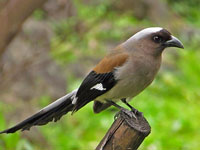
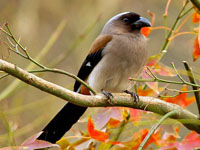
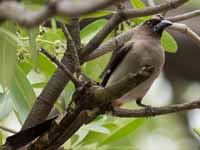
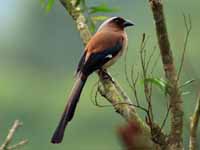
Treepie,_Rufous Dendrocitta vagabunda
Description: The rufous treepie has a black head and neck. It has a rufous mantle, bluish grey tail tipped with black, fawn lower breast and belly, black bill and legs. It is 46 t0 50 cm long and about 110 grams. The nest is made of thorny twigs and lined with small twigs and placed in a good sized tree.
Range: Indian Subcontinent, Southeast Asia.
Habitat: Various woodlands, isolated trees in more open country.
Diet: Insects, snails, small mammels, small birds.
Conservation status: Least Concern.
Image by: 1) Manjith Kainickara - India 2) Arun_Prabhu - India 3) Imran_Shah - PakistanRange: Indian Subcontinent, Southeast Asia.
Habitat: Various woodlands, isolated trees in more open country.
Diet: Insects, snails, small mammels, small birds.
Conservation status: Least Concern.
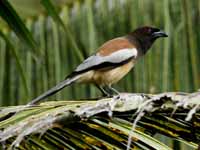

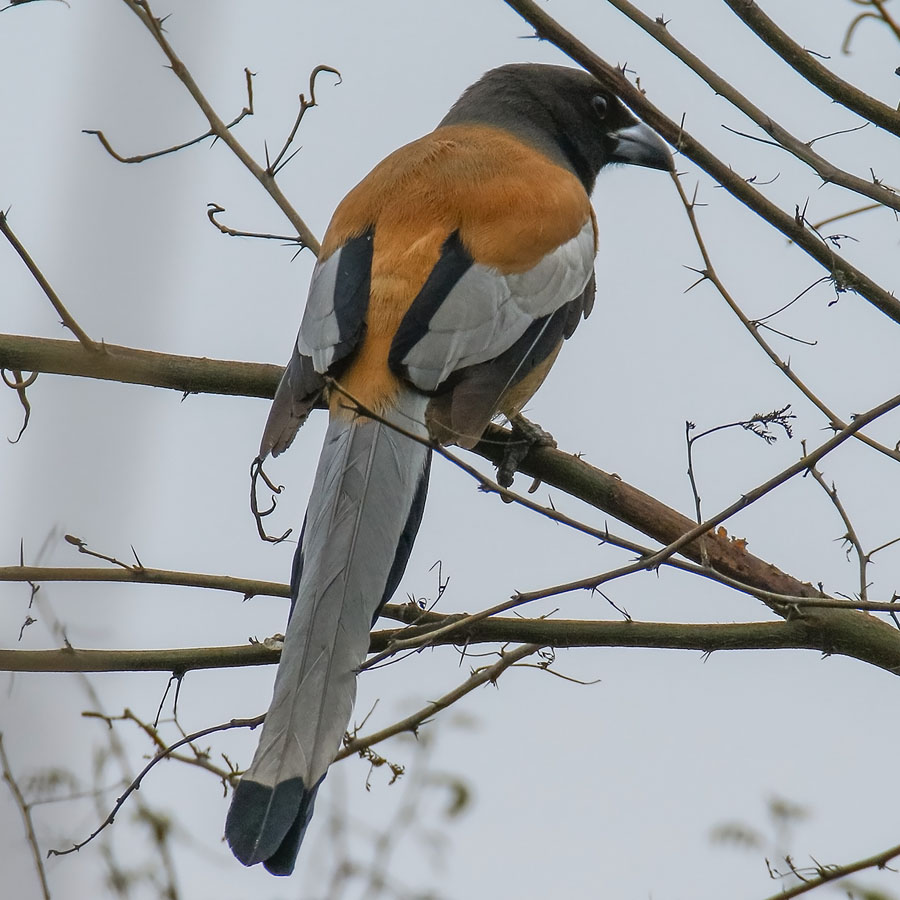
Treepie,_Sumatran Dendrocitta occipitalis
Description: Most of the head and throat of the Sumatran treepie, also known as the Sunda treepie, are dark brown. The rear of the crown and the nape are white. It has a light brown mantle, pale grey rump andupper-tail coverts, plus black upper wing with a white patch. The long graduated tail is mostly white with a black terminal band and black edges. It has a blackish bill and legs. The Sumatran treepie is 40 cm long and weighs about 95 grams. The
Bornean treepie is sometimes considered a subspecies of the Sumatran treepie.
Range: Island of Sumtra in Indonesia.
Habitat: Hilly forests; also bamboo groves.
Diet: Unknown.
Conservation status: Least Concern.
Image by:
1) John Gerrard Keulemans Range: Island of Sumtra in Indonesia.
Habitat: Hilly forests; also bamboo groves.
Diet: Unknown.
Conservation status: Least Concern.
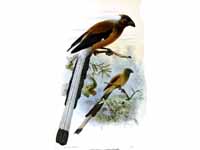
Treepie,_White-bellied Dendrocitta leucogastra
Description: The white-bellied treepie has white underparts. a white nape, and a chestnut-brown back. The face, bib, and wings are black. There is a white spot on the wings. The long graduated tail is mostly silver-grey with a wide black terminal band. Also, the edges of the tail are black. It is 45 to 48 cm in length and weighs about 125 grams.
Range: Southern India.
Habitat: Forest, abandoned plantations. Avoids human contact.
Diet: Fruits, seeds, nectar, invertebrates, reptiles, rodents, nestlings and eggs.
Conservation status: Least Concern.
Image by: 1) Lip Kee 2) Vivekpuliyeri 3) Mike_BarthRange: Southern India.
Habitat: Forest, abandoned plantations. Avoids human contact.
Diet: Fruits, seeds, nectar, invertebrates, reptiles, rodents, nestlings and eggs.
Conservation status: Least Concern.
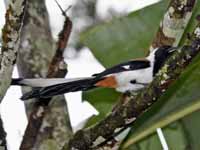
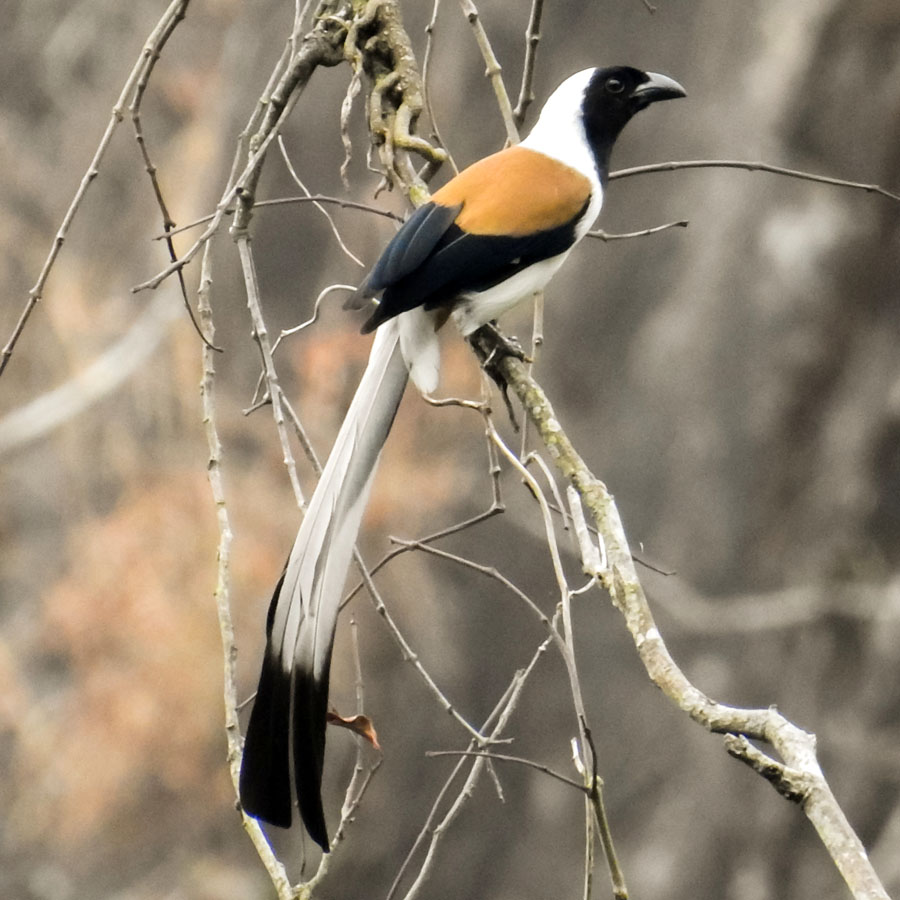
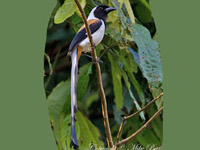
Genus Platysmurus - 1 species
Magpie,_Black Platysmurus leucopterus
Description: As the black magpies's name implies, at one time it was thought to be a magpie before it was determined to be one of the treepies. There are two subspecies: the Malay (P. l. leucopterus) and the Bornean (P. l. aterrimus). The Bornean has all black plumage white the Malay has some white on the wings. They both have short bristle-like forehead feathers that produce a small crest. The crest is more prominent on the Bornean subspecies. Some split the two subspecies into 2 distinct speices. They are 38 to 41 cm and about 180 grams.
Range: Southeast Asia, Indonesia, Malaysia.
Habitat: Mature trees with a high canopy. Also frequents village clearings.
Diet: Caterpillars, beetles, fruit. More information needed.
Conservation status: Least Concern.
Image by: 1) Lip Kee - Malaysia 2) Mike_PrinceRange: Southeast Asia, Indonesia, Malaysia.
Habitat: Mature trees with a high canopy. Also frequents village clearings.
Diet: Caterpillars, beetles, fruit. More information needed.
Conservation status: Least Concern.
1) Malay 2) Bornean
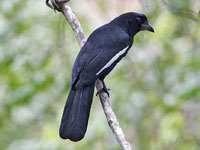
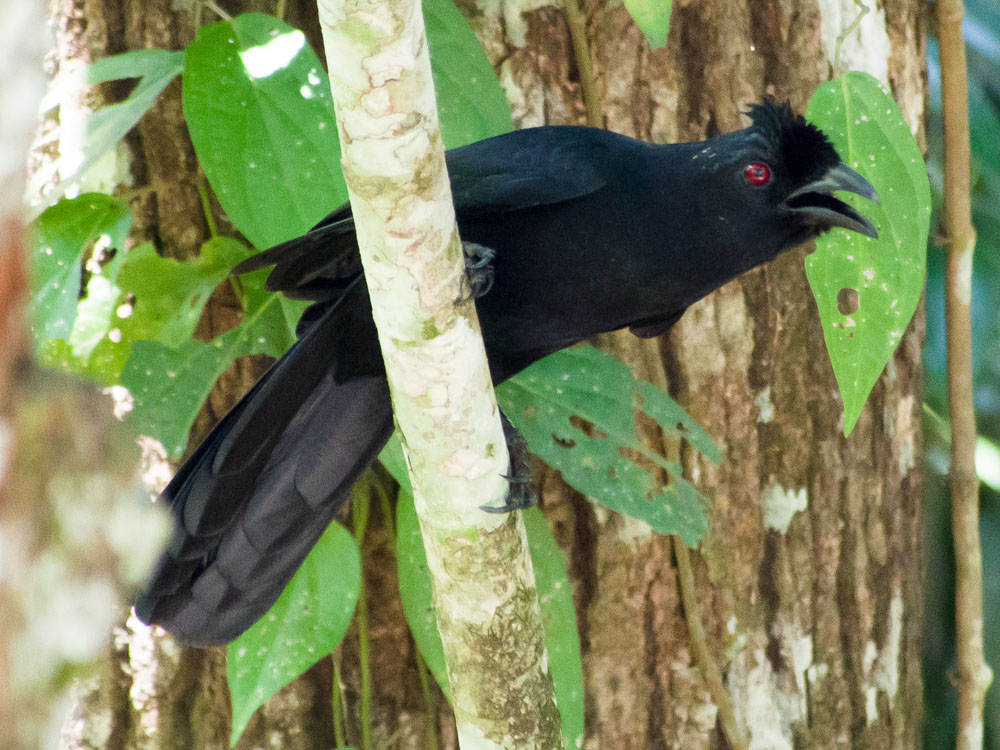
Genus Temnurus - 1 species
Treepie,_Ratchet-tailed Temnurus temnurus Found:
Description: The ratchet-tailed treepie has blackish plumage. Its long graduated tail is striking with its graduated sections each ending in a flair. For a treepie it is modest sized at 32 to 35 cm, but that is because its tail is shorter than average. However it is actually a heavy treepie at a weight of 138 grams.
Range: Southeast Asia and China.
Habitat: Tropical moist broadleaf evergreen lowland forests, secondary forest, scrubland.
Diet: Insects and other invertebrates. Specific information is lacking.
Conservation status: Least Concern.
d
Image by:
1) Nicholas LeJeune 2) JasonBkk 3) Dave_Curtis - ThailandRange: Southeast Asia and China.
Habitat: Tropical moist broadleaf evergreen lowland forests, secondary forest, scrubland.
Diet: Insects and other invertebrates. Specific information is lacking.
Conservation status: Least Concern.
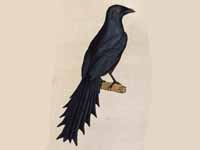
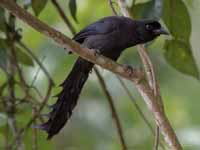
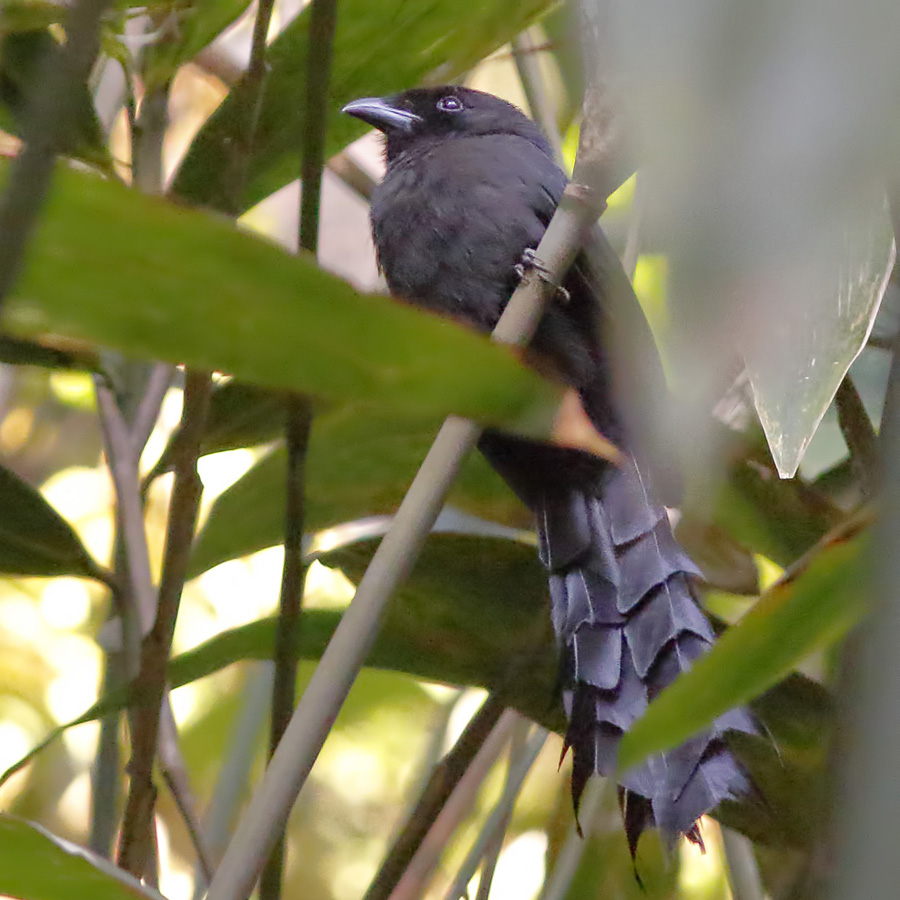
Subfamily Pyrrhocorax - Chough
This article is about two species of corvids called chough. They are included here with the treepies because DNA studies indicate that their nearest relative is the ratchet-tailed treepie. These two choughs are the alpine chough and the red-billed chough. They are both members of the genus Pyrrhocorax. The white-winged chough, while looking and acting simiar to these two choughs, is not even in the corvidae family. Evolution has cause two disparate genera to look as if they are closely related while that is not the case.
The two choughs in this corvidae subfamily both have black plumage, brightly colored bills, and brightly colored legs. They are monogamous and build nests with stick and roots plus softer material to line it. It is constructed on a cliff, in a cave, or similar man-made structure. Their incubation period is 2 to 3 weeks and fledging takes another 4 weeks or more. They are mainly carnivores, eating such things as ants, grasshoppers, beetles. These choughs also eat seeds, grain, and fruit.
Genus Pyrrhocorax
The choughs are resident in the mountains.. They have long broad wings and perform spectacular aerobatics. They build a lined stick nest and lay three to five eggs. They feed, usually in flocks, on short grazed grassland, taking mainly invertebrate prey, supplemented by vegetable material or food from human habitation, especially in winter.
Chough,_Alpine Pyrrhocorax graculus
Description: The alpine chough, also known as the yellow-billed chough, has glossy black plumage, a yellow bill, and red legs. The flight of the alpine chough is swift and acrobatic with loose deep wing beats. Its high maneuverability is accomplished by fanning the tail, folding its wings, and soaring in the rising air at cliff faces. The alpine chough is 34 to 38 cm long and weighs 150 to 275 grams.
Range: Europe, Asia, Africa.
Habitat: Mountains and high fields. It decends somewhat to lower altitudes in the winter.
Diet: In the summer it frequents pastures to capture beetles, snails, grasshoppers, caterpillars and fly larvae. This high protein diet is probably related to raising young. At other times it becomes more of a vegetarian eating fruit, seeds, grain.. It also visits garbage dumps and will seek out humans for handouts.
Conservation status: Least Concern.
Image by: 1) Gunter Hildebrandt 2) Mathias
Bigge - Austria 3) Charlie Westerinen - Switzerland 4) Imran_Shah - PakistanRange: Europe, Asia, Africa.
Habitat: Mountains and high fields. It decends somewhat to lower altitudes in the winter.
Diet: In the summer it frequents pastures to capture beetles, snails, grasshoppers, caterpillars and fly larvae. This high protein diet is probably related to raising young. At other times it becomes more of a vegetarian eating fruit, seeds, grain.. It also visits garbage dumps and will seek out humans for handouts.
Conservation status: Least Concern.
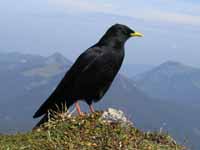
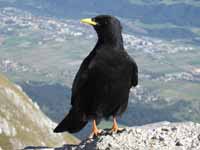

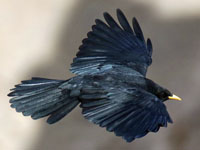
Chough,_Red-billed Pyrrhocorax pyrrhocorax
Description: The red-billed chough has glossy black plumage, a long curved red bill, and red legs. The red-billed chough has a more rectangular tail the the alpine chough. It usually nesta at lower altitudes than the alpine chough. It is 38 to 41 cm long which makes it a little larger than the alpine chough.
Range: Europe, Asia, Africa.
Habitat: Mountains and high fields. Also, western coastal cliffs.
Diet: In the summer, mainly carnivorous: insects, spiders, worms. Other times: fruit, seeds, grain.
Conservation status: Least Concern.
Image by: 1) Malte Uhl 2) Dibyendu Ash - India 3) Paul Roberts - Wales 4) Andrew - EnglandRange: Europe, Asia, Africa.
Habitat: Mountains and high fields. Also, western coastal cliffs.
Diet: In the summer, mainly carnivorous: insects, spiders, worms. Other times: fruit, seeds, grain.
Conservation status: Least Concern.
